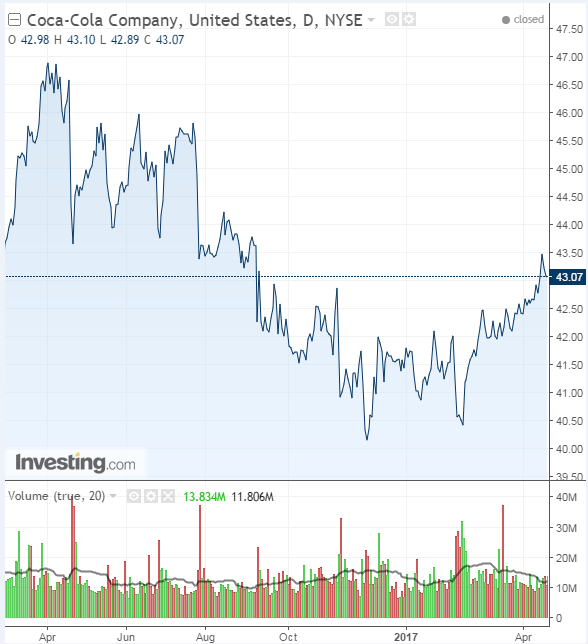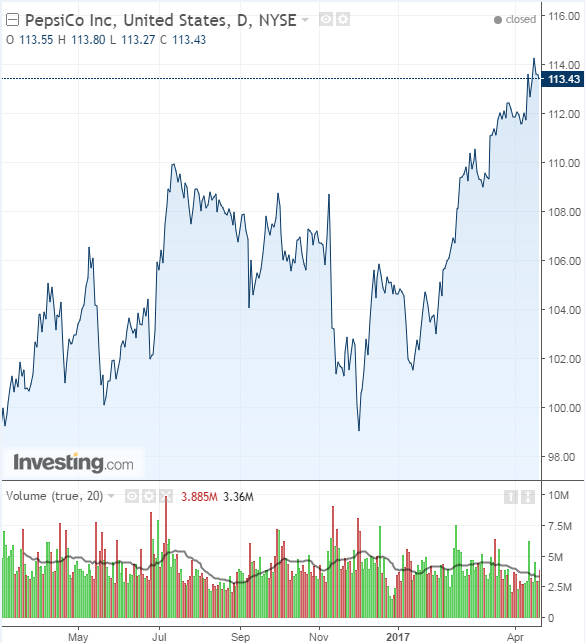by Clement Thibault
Coke vs Pepsi 2.0
At the beginning of last year, we took a comparative look at Coca Cola (NYSE:KO) versus PepsiCo (NYSE:PEP). At that time we tried to figure out which was the better investment. Our analysis was pretty conclusive—we determined that the 2016 outlook for PepsiCo seemed both safer and had better potential.
In retrospect, we believe we made the right call. While PepsiCo's share price rose from $97 to $113, +16%, Coca Cola's share price rose just 1.5% in the same timeframe, from $42.5 to $43.

Coca Cola will report Q1 2017 results on Tuesday, April 25, before the market opens. The company is expected to report revenue of $8.9 billion and EPS of $0.44.

PepsiCo will report the following day, Wednesday, April 26, before the market opens. Wall Street is looking for $11.9 billion in revenue and an EPS of $0.9.
1. 2016 Results
PepsiCo's revenues were flat on the year ($63 billion in 2015, $62.7 billion in 2016), but that's not as bad as it sounds. The company's two biggest segments, North America Beverages (NAB) and Frito-Lay North America (FLNA), grew by 3% and 5% respectively. Together, these two segments account for 58% of PepsiCo's revenues (34% NAB, 24% FLNA), so there is growth.
The biggest negative impact was felt in Latin America, where PepsiCo's revenue shrank by 17% or $2.6 billion dollars, a direct result of a strong dollar (-11%), and Venezuela's economic deconsolidation (-14%). However, PepsiCo's brands are still doing well in the rest of the region and worldwide, with 9% organic growth in LatAm and 4% organic growth across the global business. The key numbers, however, are the 17% growth in operating profit and 2.3% growth in operating margins, driven by higher efficiency and last year's Venezuela impairment charges.
Coca Cola revenues dropped by 5% in 2016 ($44 billion in 2015, $42 billion in 2016). Not surprising, its situation is fairly similar to PepsiCo's. Coke's North American revenue has grown by 4%, but restructuring and currency effects have had a major hand in bringing Coca Cola's total revenue down. Organically, Coca Cola's revenues are up 3% across the business for 2016 but the company's strategic decision to divest from its bottling operation has had a significant impact, bringing revenues down by an estimated $3 billion.
Another important point to note is that Coke's revenue split is 52/48 in favor of its international segments, while PepsiCo's split is 58/42 in favor of its U.S operations. While this may become a future growth advantage for Coca Cola, currently the split is detrimental—at least for as long as the U.S. dollar remains strong.
2. Dividends
Last year, Coca Cola and PepsiCo dividends were almost identical, but not this year. When our previous article was published, Coca Cola yielded 3.07% while PepsiCo yielded 2.84%, but changes in stock prices and dividend growth have widened the gap between Coke and Pepsi on this metric.
Currently, Coca Cola's yield is 3.25%, while PepsiCo's has fallen to 2.65%. In essence, the gap between the two yields has doubled.
Both dividends are safe; Coca Cola's payout ratio is 92% while Pepsi's is 67%. But don't set off any alarm bells because of the yield divergence; both companies are Dividend Aristocrats, S&P 500 companies that have reliably paid out and grown their dividends for 25 years or more. PepsiCo has grown its dividend for the past 44 years; Coca Cola for the past 54 years.
3. Longer-Term Outlook
Both companies have capable management and are in good hands. Both companies are aware of consumer health trends and are increasing efforts to bring new, related products to the market, such as Coca Cola's Fairlife, a healthy dairy beverage, or PepsiCo's Tropicana Probiotics, juice infused with active probiotic cultures. Both companies are expected to continue growing dollar revenue in the U.S and organic revenue abroad.
One worry stems from Coca Cola's current massive undertaking—divestiture of its bottling operation, which will continue in 2017. The bottling operation represents over 40% of the company's revenue. However, the goal is to move away from the lower margin, capital intensive manufacturing, bottling and distribution business in order to focus on the core beverage concentrate business which is significantly more profitable.
To that end, Coca Cola is on track to refranchise and sell all its U.S. bottling plants by the end of the year. While the company views the move as strategically important for the future, it throws a wrench into the works for Coca Cola's expected revenues and profitability in the near-term.
Conclusion
Coca Cola's P/E ratio is 29, compared to PepsiCo's 26. Its Price-to-Free Cash Flow is also 29, compared to PepsiCo's 22.
PepsiCo's path to continued growth and prosperity has fewer obstacles ahead (not as much business abroad, no big restructuring initiative), compared to Coca Cola's challenges, and its growth is expected to continue without too much difficulty. As of today, PepsiCo's short term growth prospects are more promising, making PepsiCo's shares the better deal.
However, we believe Coca Cola is doing the right thing by transforming its business and divesting from parts of its heavy manufacturing segment. The problem is that investors, like all humans, do not necessarily appreciate change, at least until the results are revealed as positive. This, coupled with ongoing dollar strength, could mean that Coca Cola's 2017 will look very much like its 2016 – pretty bleak.
Longer term though, both are great companies with strong product portfolios, excellent management, and both will likely continue to dominate the market for years to come. If you're looking to open a position, we could see PepsiCo coming back down to retest $100-105 levels, or 7-10% lower than right now, creating an opportunity. Coca Cola could fall another 10% or so in the course of the year, to $39. If no new, major crises hit either company, both should be great long-term opportunities at these respective price points.
